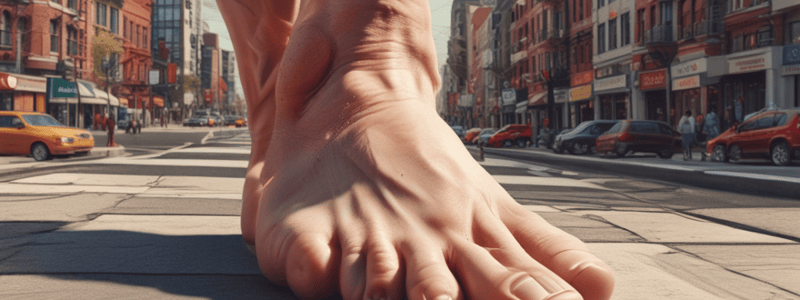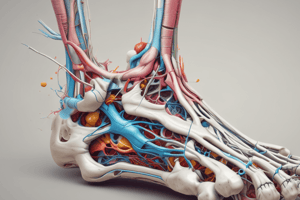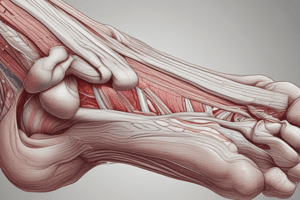Podcast
Questions and Answers
Which of the following is the most reliable indicator of a weightbearing radiographic view?
Which of the following is the most reliable indicator of a weightbearing radiographic view?
- The position of the metatarsals relative to the heel (correct)
- The position of the calcaneus
- The presence of the plantar soft tissues
- The angle of the distal tibia
What is the primary indication for obtaining non-weightbearing radiographic views of the foot?
What is the primary indication for obtaining non-weightbearing radiographic views of the foot?
- To evaluate for soft tissue swelling
- To better evaluate the alignment of the bones
- To assess for joint space narrowing
- Trauma (correct)
Which radiographic view would best demonstrate the relationship between the metatarsals and the heel?
Which radiographic view would best demonstrate the relationship between the metatarsals and the heel?
- Axial calcaneal
- Anteroposterior
- Lateral (correct)
- Medial oblique
In a skeletally mature individual, which radiographic view would best demonstrate the alignment of the tarsal and metatarsal bones?
In a skeletally mature individual, which radiographic view would best demonstrate the alignment of the tarsal and metatarsal bones?
Which of the following radiographic landmarks would be most clearly visualized on a lateral foot view?
Which of the following radiographic landmarks would be most clearly visualized on a lateral foot view?
In an anteroposterior (AP) or oblique view of the foot, how can you determine if the image is of the right or left foot?
In an anteroposterior (AP) or oblique view of the foot, how can you determine if the image is of the right or left foot?
What is the key difference between a skeletally immature and skeletally mature foot/ankle radiograph?
What is the key difference between a skeletally immature and skeletally mature foot/ankle radiograph?
In a non-weightbearing position, which of the following foot/ankle radiographic views would you expect to see?
In a non-weightbearing position, which of the following foot/ankle radiographic views would you expect to see?
In a medial oblique view of the foot, which of the following bones would be most prominently visualized?
In a medial oblique view of the foot, which of the following bones would be most prominently visualized?
What is the key difference between a weightbearing and non-weightbearing foot/ankle radiograph?
What is the key difference between a weightbearing and non-weightbearing foot/ankle radiograph?
In a lateral view of the foot, which of the following bones would be most prominently visualized?
In a lateral view of the foot, which of the following bones would be most prominently visualized?
In the anteroposterior (AP) foot view, the metatarsal parabola is best described as:
In the anteroposterior (AP) foot view, the metatarsal parabola is best described as:
Which of the following structures is NOT visualized on the medial oblique (MO) foot view?
Which of the following structures is NOT visualized on the medial oblique (MO) foot view?
On the lateral (LAT) foot view, which of the following is NOT a structure that can be evaluated?
On the lateral (LAT) foot view, which of the following is NOT a structure that can be evaluated?
In a weightbearing position, which of the following views would be most useful in evaluating for a potential coalition?
In a weightbearing position, which of the following views would be most useful in evaluating for a potential coalition?
Which of the following statements is TRUE regarding the sesamoid axial (SA) view?
Which of the following statements is TRUE regarding the sesamoid axial (SA) view?
In a skeletally immature individual, which of the following views would be most useful in evaluating the tibiofibular overlap?
In a skeletally immature individual, which of the following views would be most useful in evaluating the tibiofibular overlap?
Flashcards
Reliable Weightbearing Indicator
Reliable Weightbearing Indicator
The position of the metatarsals relative to the heel.
Primary Indication for Non-Weightbearing Views
Primary Indication for Non-Weightbearing Views
Trauma.
View Demonstrating Metatarsal-Heel Relationship
View Demonstrating Metatarsal-Heel Relationship
Lateral view.
View Demonstrating Tarsal-Metatarsal Alignment (Mature)
View Demonstrating Tarsal-Metatarsal Alignment (Mature)
Signup and view all the flashcards
Radiographic Landmark on Lateral Foot View
Radiographic Landmark on Lateral Foot View
Signup and view all the flashcards
Determining Foot Side (AP/Oblique View)
Determining Foot Side (AP/Oblique View)
Signup and view all the flashcards
Key Difference: Immature vs. Mature Radiograph
Key Difference: Immature vs. Mature Radiograph
Signup and view all the flashcards
Non-Weightbearing Foot/Ankle Radiographic View
Non-Weightbearing Foot/Ankle Radiographic View
Signup and view all the flashcards
Most Prominently Visualized Bone in Medial Oblique View
Most Prominently Visualized Bone in Medial Oblique View
Signup and view all the flashcards
Key Difference: Weightbearing vs. Non-Weightbearing Radiograph
Key Difference: Weightbearing vs. Non-Weightbearing Radiograph
Signup and view all the flashcards
Most Prominently Visualized Bone in Lateral View of Foot
Most Prominently Visualized Bone in Lateral View of Foot
Signup and view all the flashcards
Metatarsal Parabola
Metatarsal Parabola
Signup and view all the flashcards
Structure Not Visualized on Medial Oblique Foot View
Structure Not Visualized on Medial Oblique Foot View
Signup and view all the flashcards
Structure NOT Evaluated on Lateral Foot View
Structure NOT Evaluated on Lateral Foot View
Signup and view all the flashcards
View for Evaluating Potential Coalition (Weightbearing)
View for Evaluating Potential Coalition (Weightbearing)
Signup and view all the flashcards
Sesamoid Axial View
Sesamoid Axial View
Signup and view all the flashcards
View for Tibiofibular Overlap (Immature)
View for Tibiofibular Overlap (Immature)
Signup and view all the flashcards
Study Notes
WEIGHTBEARING VS NONWEIGHTBEARING
- Lateral image determines if it's weightbearing or non-weightbearing
- Weightbearing: heel and metatarsals are on the same plane
- Non-weightbearing: metatarsals are plantarflexed in relation to the heel
- Assume all images are weightbearing if not marked
- Assume all images are non-weightbearing if not marked
- Weightbearing often yields more information than non-weightbearing
- Non-weightbearing films are usually only indicated for trauma
INTRODUCTORY STATEMENT
- Start with "I am looking at (number) views of the (left/right foot/ankle) of a skeletally (mature/immature) individual in a (non-weightbearing/weightbearing) position"
- List all the image views seen
SKELETALLY IMMATURE VS MATURE
- Immature bone has at least one open growth plate
- Mature bone has no open growth plates
NORMAL ANATOMY AND LANDMARKS
Anteroposterior (AP) Foot View
- Forefoot to rearfoot relationship
- First ray
- Metatarsal parabola
- MTPJs
- Sesamoid position
- Navicular body
Medial Oblique (MO) Foot View
- Lateral column
- Cuboid
- Lateral pole of the navicular
- Fibular sesamoid
- TMTJs
Lateral (LAT) Foot View
- Ankle joint
- Subtalar joint
- Forefoot to rearfoot relationship
- First ray position
- Medial column
Lateral Oblique (LO) Foot View
- Medial column
- Navicular tuberosity
- Tibial sesamoid
Sesamoid Axial (SA) View
- Sesamoid articulations
- Sesamoid position
- Frontal plane rotation of the 1st metatarsal
Calcaneal Axial (CA) View
- Calcaneal position
- Subtalar joint
- Coalitions
Anteroposterior (AP) Ankle View
- Medial gutter
- Medial malleolus
- Tibiofibular overlap
Anteroposterior (AP) Mortise Ankle View
- Ankle joint
- Syndesmosis
- Lateral gutter
Lateral (LAT) Ankle View
- Ankle joint
- Subtalar joint
- CC joint
- TN joint
Studying That Suits You
Use AI to generate personalized quizzes and flashcards to suit your learning preferences.




